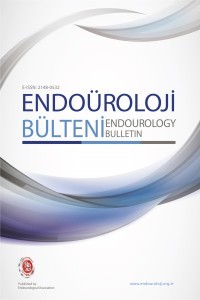Endoskopik Taş Tedavisinde Gelecekte Bizleri Ne Bekliyor?
endoskopik, endoüroloji, gelecek, laser, taş, yenilikler
What does expect us in endoscopic stone treatment in the future?
endoscopic, endourology, future, lazer, stone, innovations,
___
- 1- José Manuel Reis Santos. Ureteroscopy from the recent past to the near future. Urolithiasis. 2018 Feb;46(1):31-37. doi: 10.1007/s00240-017-1016-8. Epub 2017 Nov 29
- 2- Raheem OA , Khandwala YS , Sur RL,Ghani KR , Denstedt JD. Burden of Urolithiasis: Trends in Prevalence, Treatments, and Costs. Eur Urol Focus. 2017;3:18-26
- 3- Li JK, Teoh JY,Ng CF. Updates in endourological management of urolithiasis. Int J Urol.2019:26;172-183
- 4- Ghani KR, Andonian S, Bultitude M, Desai M, Giusti G, Okhunov Z, Preminger GM, de la Rosette J. Percutaneous Nephrolithotomy: Update, Trends, and Future Directions.Eur Urol.2016:70;382-396
- 5- Jung HD, Kim JC, Ahn HK, Kwon JH, Han K, Han WK, Kim MD, Lee JY. Real-time simultaneous endoscopic combined intrarenal surgery with intermediate-supine position: Washout mechanism and transport technique. İnvestig Clin Urol.2018:59;348-354
- 6- Alyaev YG, Sirota ES, Bezrukov EA, Ali SK, Bukatov MD, Letunovsky AV, Byadretdinov IS. V01-10 Non-Bıologıcal 3d Prınted Sımulator For Percutaneous Nephrolıthotrıpsy. Urologgia. 2018:1;10-14
- 7- Tareq Aro, Sunghwan Lim, Doru Petrisor, Dan Stoianovici, Baltimore, MD. Mp20-09 Robotıc 3d Ultrasound-Guıded Targetıng For Percutaneous Renal Access.The Journal Of Urology, Vol. 201, No. 4S, Supplement, Friday, May 3, 2019
- 8- Rassweiler-Seyfried MC,Rassweiler JJ, Weiss C, Müller M, Meinzer HP,Mailer-Hein L,Klein JT. iPad assisted percutaneous nephrolithotomy (PCNL): a matched pair analysis compared to standard PCNL.World J Urol. 2019;345-019
- 9- A. Rodgers A. Trinchieri A, Ather MH,· N. Buchholz N, Vision for the future on urolithiasis: research, management, education and training—some personal views .Urolithiasis 2018;240-018
- 10- Wright AE, Rukin NJ, Somani BK. Ureteroscopy and Stones: Current Status and future expectations. World J Nephrol. 2014;3:243-8
- 11- Davis NF,Quinlan MR, Browne C, Bhatt NR, Manecksha RP, D’Arcy FT, Lawrentschuk N, Bolton DM. Single use fexible ureteropyeloscopy: a systematic review. Wold J Urol.2018;36:529-536
- 12- Mager R, Kurosch M, Höfner T, Frees S, Haferkamp A, Neisius A; Clinical outcomes and costs of reusable and single-use flexible ureterorenoscopes: a prospective cohort study, Urolithiasis. 2018 Nov;46(6):587-593. doi: 10.1007/s00240-018-1042-1. Epub 2018 Jan 22
- 13- Lange B, Cordes J, Brinkmann R. Stone/tissue differentiation for holmium laser lithotripsy using autofluorescence.Lasers Surg Med. 2015:47;737-44
- 14- Elhilali MM1, Badaan S2, Ibrahim A1,3, Andonian S1. Use of the Moses Technology to Improve Holmium Laser Lithotripsy Outcomes: A Preclinical Study. J Endourol. 2017:31;598-604
- 15- P. Glybochko G. Altshuler A. Vinarov L. Rapoport M. Enikeev N. Grigoriev D. Enikeev N. Sorokin , A. Dymov R. Sukhanov M. Taratkin V. Zamyatina. Comparison between the possibilities of holmium and thulium laser in lithotripsy in vitro. European Urology Supplements
- 16- Müller PF,Schlager D, Hein S, Bach C,Miernik A,Schoeb DS. Robotic stone surgery – Current state and future prospects: A systematic review. Arab J Urol. 2017:16;357-364
- 17- Alireza Shamsabadi Masoudi,Mohammad Sadegh Hassanli, Zahra Taavili, Yasaman Sadeghizade. Biomedical and Micro-Robots: An Overview of Recent Developments. Chemical and Biomolecular Engineering 2017; 2(2): 90-95
- Yayın Aralığı: Yılda 3 Sayı
- Başlangıç: 2020
- Yayıncı: ENDOÜROLOJİ DERNEĞİ
Genç populasyonda mesane tümörlerinin klinik ve patolojik özellikleri
Sercan YILMAZ, Ali YILDIZ, Serdar YALÇIN, Can SİCİMLİ, Ali Fuat ÇİÇEK, Bahadır TOPUZ, Selahattin BEDİR
Endoskopik Kombine İntrarenal Cerrahi
Bahadır TOPUZ, Sercan YILMAZ, Serdar YALÇIN, Sanan ASGARLI, Engin KAYA, Murat ZOR, Mesut GÜRDAL, Selahattin BEDİR
COVID-19 pandemisi sırasında üriner sistem taş hastalığının yönetimi: tek merkez deneyimi
Gökhan ECER, Mehmet Giray SÖNMEZ, İbrahim GÖKSOY, Mert ARSLANER, Hakan TAŞKAPU, Arif AYDIN, Mehmet BALASAR
Endoskopik Taş Tedavisinde Gelecekte Bizleri Ne Bekliyor?
Fatih SANDIKÇI, Burhan BAYLAN, Abdurrahim İMAMOĞLU
Retzius Koruyucu Robot Yardımlı Laparoskopik Radikal Prostatektomi
Serkan ALTINOVA, Çağrı GÜNERİ, Muhammet Fuat ÖZCAN
Laparoskopik üreterolitotomi; siz hangi yolu tercih ediyorsunuz?
Laparoskopik nefrektomide spesmen çıkarma yönteminin hasta memnuniyetine etkisi
Serkan DOĞAN, Bülent ÇELİK, Mehmet YILMAZ
Thulium Lazer ile Prostat Enükleasyonu(ThuLEP) deneyimleri
Eymen GAZEL, Mehmet YILMAZ, Halil Çağrı AYBAL, Engin KAYA, Serdar YALÇIN, Sercan YILMAZ, Onur AÇIKGÖZ, Lütfi TUNÇ
